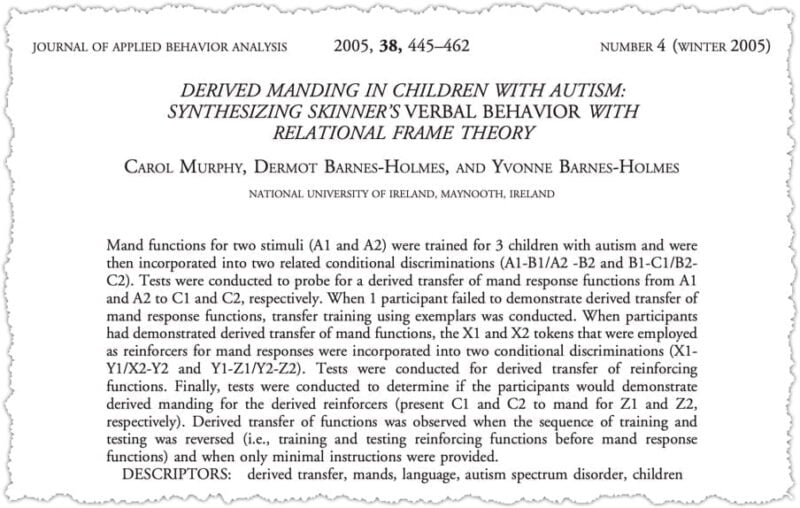Derived Manding in Children with Autism: Synthesizing Skinner’s Verbal Behavior with Relational Frame Theory
$9.99
BCBA CEUs: 1 CEU
Read the following article and pass a 6-question quiz on it:
Murphy, C., Barnes-Holmes, D., & Barnes-Holmes, Y. (2005). Derived manding in children with autism: Synthesizing Skinner’s Verbal Behavior with relational frame theory. Journal of Applied Behavior Analysis, 38(4), 445-462.
Brand: CEUniverse
Description
To earn credit, you will be required to read the article and pass a 6-question quiz about it. You can retake the quiz as many times as needed, but you will not receive exactly the same questions each time.
Abstract
Mand functions for two stimuli (A1 and A2) were trained for 3 children with autism and were then incorporated into two related conditional discriminations (A1-B1/A2 -B2 and B1-C1/B2-C2). Tests were conducted to probe for a derived transfer of mand response functions from A1 and A2 to C1 and C2, respectively. When 1 participant failed to demonstrate derived transfer of mand response functions, transfer training using exemplars was conducted. When participants had demonstrated derived transfer of mand functions, the X1 and X2 tokens that were employed as reinforcers for mand responses were incorporated into two conditional discriminations (X1-Y1/X2-Y2 and Y1-Z1/Y2-Z2). Tests were conducted for derived transfer of reinforcing functions. Finally, tests were conducted to determine if the participants would demonstrate derived manding for the derived reinforcers (present C1 and C2 to mand for Z1 and Z2, respectively). Derived transfer of functions was observed when the sequence of training and testing was reversed (i.e., training and testing reinforcing functions before mand response functions) and when only minimal instructions were provided.
16 reviews for Derived Manding in Children with Autism: Synthesizing Skinner’s Verbal Behavior with Relational Frame Theory
| 5 star | 62 | 62% |
| 4 star | 25 | 25% |
| 3 star | 12 | 12% |
| 2 star | 0% | |
| 1 star | 0% |
Sorry, no reviews match your current selections
You may also like…
-
Article Quiz

3.5 Total BCBA CEUs
3.5 Ethics CEUsA Case Study in the Misrepresentation of Applied Behavior Analysis in Autism: The Gernsbacher Lectures
Edward K. Morris4.39 out of 5(57)$34.99 Add to Cart Quick View -
BundleSale!

32 Total BCBA CEUs
4 Ethics CEUs3 Supervision CEUs25 General CEUsGalactic Bundle
5.00 out of 5(1)$319.87Original price was: $319.87.$216.98Current price is: $216.98. Add to Cart Quick View -
Multimedia Tutorial

7 BCBA CEUs
An Introduction to Relational Frame Theory (RFT)
Eric J. Fox4.55 out of 5(503)$69.99 Add to Cart Quick View
Related products
-
Article Quiz

1.5 BCBA CEUs
Navigating a Managed Care Peer Review
Kathleen J. Papatola & Stuart L. Lustig4.50 out of 5(2)$14.99 Add to Cart Quick View -
Interactive Video

2 BCBA CEUs
B.F. Skinner on Behaviorism and Verbal Behavior
B.F. Skinner & Eve Segal4.50 out of 5(2)$19.99 Add to Cart Quick View -
Multimedia Tutorial

8 BCBA CEUs
An Introduction to Verbal Behavior
Norman Peterson4.24 out of 5(306)$79.99 Add to Cart Quick View











Useful information on a common topic I work on with my clients.
This was a useful article to show application of RFT. I’ve been interested in RFT but I haven’t seen enough examples of how to use within functional communication.
Quite long but detailed. Will be useful to figure out how to present the information in a more synthesized way.
Hurt my brain in a good way. Lol.
Useful paper.